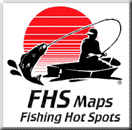 |
|
|
Click on the image to vote for this site. Want to join The Top 1000 Fishing Sites, click here! Want to view the list, click here!
|
The Fall Bite by Dan Vinovich Over the last year, I have fished all over Illinois. I still think the Illinois River is your best bet for consistency on sauger and walleye. A lot of people have trouble when they first start fishing the Illinois river. Unlike the Mississippi, the Illinois river seems to be lacking in fish holding structure readily seen by the eye. The Illinois river has no real quantity of wing dams, closing dams or long stretches of rip rap shore lines. To find fish holding structure, you have to use your electronics and your maps. Sit down before you put your boat in the water and mark classic fish holding areas. Some classic areas I look for when fishing any river are: 1. Dams
Now that I have stated the areas I would look for, let’s put these areas together with the fall movements of sauger and walleye to further increase our odds of filling our limits. As late November and December arrive, water temperatures drop into the 50 degree range. This drop in water temperature seems to merge the smaller schools of fish into large wolf packs interested in one thing, eating! Fall, in my judgment, is one of the best times to catch full stringers of big fish. Locating these packs of hungry walleye and sauger is fairly simple. When you find the food, you find the fish. Shad is the main forage base in many of our midwest lakes and rivers. In the fall, millions of shad move onto shallow mud flats to feed on the remaining invertebrates in the water column. As the invertebrates in the water column start to deplete, the shad start sifting through the silt on these flats for the remaining food, much like the American Indians followed the buffalo across the plains. The walleye and sauger follow the shad, stopping to gorge themselves on the plentiful food supply before moving into deeper holes to hold up during winter. So for fantastic fall river fishing, look for shallow flats in the 10 to 12 foot depth range. This fall bite can be aggravating at times because the fish are so stuffed
on shad they may not readily hit your offerings. There are a couple
different presentations I would try on these sluggish fish. The first
is trolling small crankbaits at hyper speeds. Remember the walleye
is an intense predator. By trolling at above normal speeds, we reach
into the very instinct of the fish. Use these predatory instincts
to produce a reaction strike. The bait runs past the fish so fast
they don’t have a chance to decide if they want the bait or not.
They just react. For this type of presentation, I have found that
the small CD5 Walleye Diver will reach targeted depths easily, and it tracks
incredibly true at high speeds. I do make one minor adjustment to
the hook since the fish is reacting on the bait instead of inhaling it.
Good hooks are a must. I replace all of my hooks with the Kahil style
Eagle Claw hook. These hooks are incredibly sharp and have an added
advantage over the standard round bend trebles in fish hooking and holding
capabilities. A must in this style of trolling is tuning your crankbaits.
The bait must track true or your presentation is doomed before you get
started. Depending on the size of the flat you are trolling, I do
recommend using planer boards to spread you baits over a greater area.
Using planer boards in the fall can be a nightmare. White bass and
leaves can foul baits without you knowing. That is why I use the Seasonal migrations in the fall can produce some of the largest stringers of walleye and sauger you will get in the course of a years fishing. So, don’t put away those boats just yet .Cool temperatures and stable water conditions should make the fall of 2000 a good one. See ya’ on the water, Dan Vinovich For guided trips call Dan Vinovich at Predator Guide Service, 309-347-1728
Please visit these site sponsors
Daiichi/Tru-Turn Hooks,
Lindy
Little Joe,
R-A.M Mounting Systems,
Ranger
boats, Mercury Marine, Bedford
Sales , Hamby's Beaching Bumpers,
Goldeneye
Marine products, Panther
Marine Products, Webfoots body
sock, Bait Rigs Tackle
|
|---|---|


